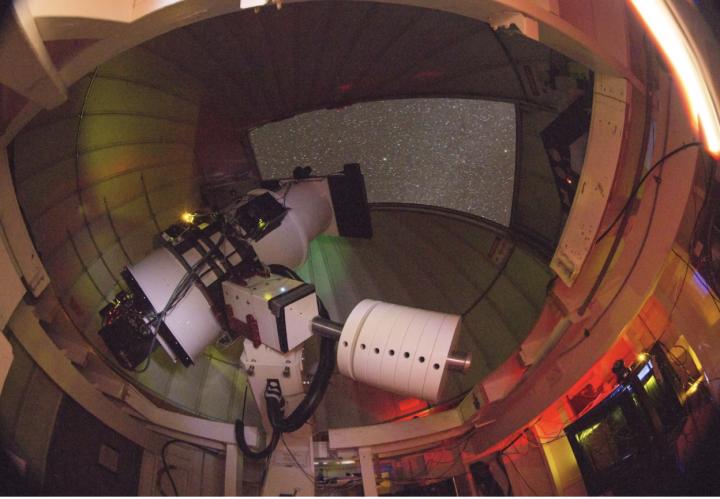ATLAS telescope discovers first-of-its-kind asteroid

ATLAS telescope unit on Haleakalā, Maui. Credit: Henry Weiland
Now, the University of Hawai'i Asteroid Terrestrial-impact Last Alert System (ATLAS) has discovered the first known Jupiter Trojan asteroid to have sprouted a comet-like tail. ATLAS is a NASA-funded project using wide-field telescopes to rapidly scan the sky for asteroids that might pose an impact threat to Earth.
But by searching most of the sky every two nights, ATLAS often finds other kinds of objects – objects that aren't dangerous, but are very interesting.
Early in June 2019, ATLAS reported what seemed to be a faint asteroid near the orbit of Jupiter. The Minor Planet Center designated the new discovery as 2019 LD2. Inspection of ATLAS images taken on June 10 by collaborators Alan Fitzsimmons and David Young at Queen's University Belfast revealed its probable cometary nature.
Follow-up observations by UH astronomer J.D. Armstrong and his student Sidney Moss on June 11 and 13 using the Las Cumbres Observatory (LCO) global telescope network confirmed the cometary nature of this body.
Later, in July 2019, new ATLAS images caught 2019 LD2 again – now truly looking like a comet, with a faint tail made of dust or gas. The asteroid passed behind the Sun and was not observable from the Earth in late 2019 and early 2020, but upon its reappearance in the night sky in April of 2020, routine ATLAS observations confirmed that it still looks like a comet. These observations showed that 2019 LD2 has probably been continuously active for almost a year.
While ATLAS has discovered more than 40 comets, what makes this object extraordinary is its orbit. The early indication that it was an asteroid near Jupiter's orbit have now been confirmed through precise measurements from many different observatories. In fact, 2019 LD2 is a special kind of asteroid called a Jupiter Trojan – and no object of this type has ever before been seen to spew out dust and gas like a comet.
Trojan asteroids follow the same orbit as a planet, but stay either around 60 degrees ahead or 60 degrees behind along the orbit. Earth has at least one Trojan asteroid, and Neptune has dozens. Jupiter has hundreds of thousands. The Jupiter Trojan asteroids orbit the Sun in two huge swarms, one swarm orbiting ahead of the planet (where 2019 LD2 was found) and one swarm orbiting behind it.
The Trojan asteroids have been captured into these orbits by Jupiter's strong gravity. What makes 2019 LD2 so interesting is that we think most Jupiter Trojans were captured billions of years ago. Any surface ice that could vaporize to spew out gas and dust should have done so long ago, leaving the objects quietly orbiting as asteroids – not behaving like comets.
“We have believed for decades that Trojan asteroids should have large amounts of ice beneath their surfaces, but never had any evidence until now. ATLAS has shown that the predictions of their icy nature may well be correct” said Fitzsimmons.
What could have made 2019 LD2 suddenly show cometary behavior? Maybe Jupiter captured it only recently from a more distant orbit where surface ice could still survive. Maybe it recently suffered a landslide or an impact from another asteroid, exposing ice that used to be buried under layers of protective rock.
New observations to find out are being acquired and evaluated. What's certain is that the Universe is full of surprises – and surveys to guard the Earth from dangerous asteroids often make unexpected discoveries of harmless but fascinating objects that can reveal more about our Solar System's history.
“Even though the ATLAS system is designed to search for dangerous asteroids, ATLAS sees other rare phenomena in our solar system and beyond while scanning the sky,” said ATLAS project principal investigator Larry Denneau. “It's a real bonus for ATLAS to make these kinds of discoveries.”
Media Contact
More Information:
http://manoa.hawaii.edu/news/article.php?aId=10683All latest news from the category: Physics and Astronomy
This area deals with the fundamental laws and building blocks of nature and how they interact, the properties and the behavior of matter, and research into space and time and their structures.
innovations-report provides in-depth reports and articles on subjects such as astrophysics, laser technologies, nuclear, quantum, particle and solid-state physics, nanotechnologies, planetary research and findings (Mars, Venus) and developments related to the Hubble Telescope.
Newest articles

Properties of new materials for microchips
… can now be measured well. Reseachers of Delft University of Technology demonstrated measuring performance properties of ultrathin silicon membranes. Making ever smaller and more powerful chips requires new ultrathin…

Floating solar’s potential
… to support sustainable development by addressing climate, water, and energy goals holistically. A new study published this week in Nature Energy raises the potential for floating solar photovoltaics (FPV)…

Skyrmions move at record speeds
… a step towards the computing of the future. An international research team led by scientists from the CNRS1 has discovered that the magnetic nanobubbles2 known as skyrmions can be…





















